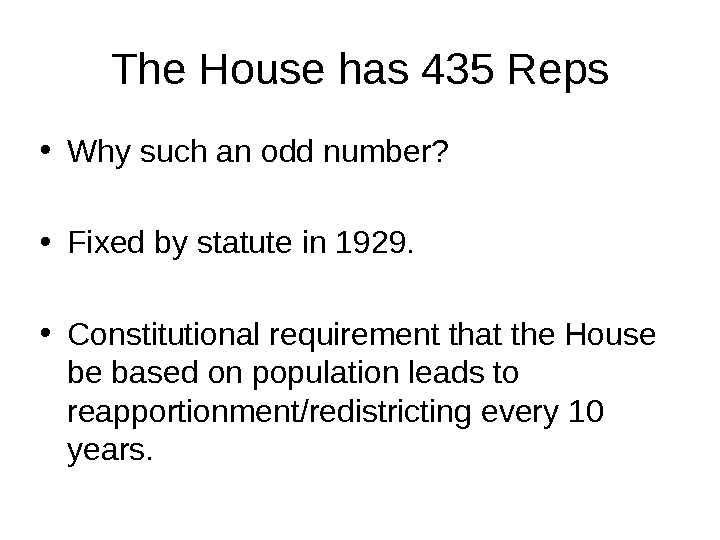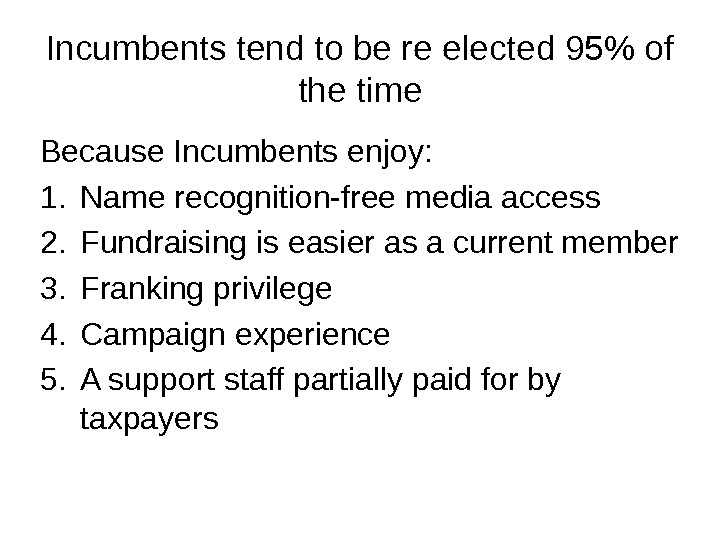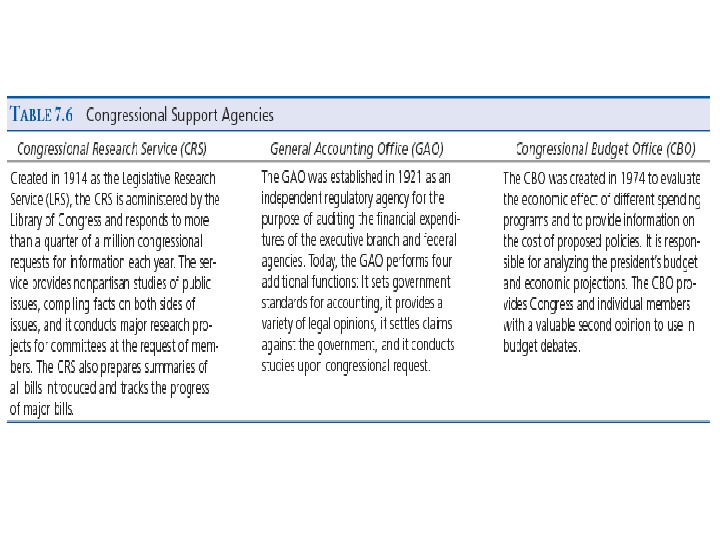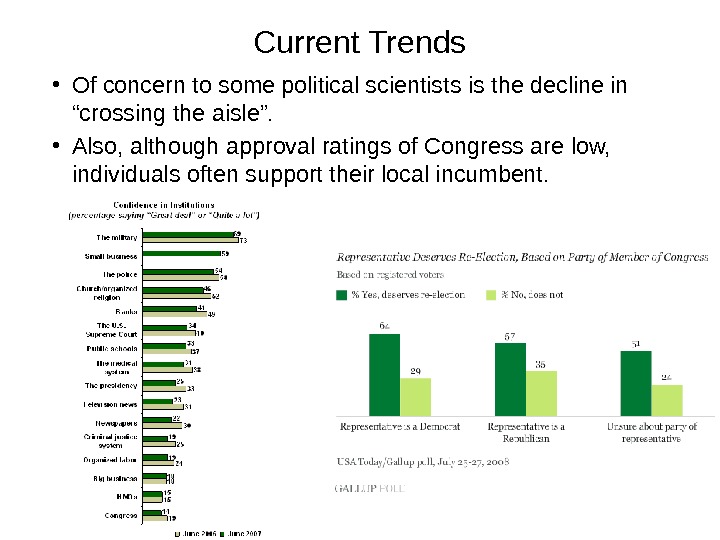Презентация congress presentation









































- Размер: 2.6 Mегабайта
- Количество слайдов: 40
Описание презентации Презентация congress presentation по слайдам
 Congress Chapter
Congress Chapter

 Constitutional Powers of Congress • The most important constitutional power of Congress is the power to make laws. • This power is shared by the House and the Senate. • In order to become a law, a bill must be passed by both the House and the Senate.
Constitutional Powers of Congress • The most important constitutional power of Congress is the power to make laws. • This power is shared by the House and the Senate. • In order to become a law, a bill must be passed by both the House and the Senate.
 Remember in the original design, the framers wanted the Senate to be more conservative So Representatives in the House have always been directly elected Senators since 1913 with the 17 th amendment
Remember in the original design, the framers wanted the Senate to be more conservative So Representatives in the House have always been directly elected Senators since 1913 with the 17 th amendment
 Formal Requirements for membership • House of Representatives- 25 years old, citizen of U. S. for 7 years, legal resident of state • Senate- 30 years old, citizen of U. S. for 9 years, legal resident of state
Formal Requirements for membership • House of Representatives- 25 years old, citizen of U. S. for 7 years, legal resident of state • Senate- 30 years old, citizen of U. S. for 9 years, legal resident of state
 The House has 435 Reps • Why such an odd number? • Fixed by statute in 1929. • Constitutional requirement that the House be based on population leads to reapportionment/redistricting every 10 years.
The House has 435 Reps • Why such an odd number? • Fixed by statute in 1929. • Constitutional requirement that the House be based on population leads to reapportionment/redistricting every 10 years.
 Apportionment and Redistricting • The Constitution requires that all Americans be counted every ten years by a census. • The census determines the representation in the House of Representatives. • Redistricting is done by state legislatures and, of course, always has political overtones.
Apportionment and Redistricting • The Constitution requires that all Americans be counted every ten years by a census. • The census determines the representation in the House of Representatives. • Redistricting is done by state legislatures and, of course, always has political overtones.
 When the process is outrageously political, it is called gerrymandering and is often struck down by the courts.
When the process is outrageously political, it is called gerrymandering and is often struck down by the courts.

 Incumbents tend to be re elected 95% of the time Because Incumbents enjoy: 1. Name recognition-free media access 2. Fundraising is easier as a current member 3. Franking privilege 4. Campaign experience 5. A support staff partially paid for by taxpayers
Incumbents tend to be re elected 95% of the time Because Incumbents enjoy: 1. Name recognition-free media access 2. Fundraising is easier as a current member 3. Franking privilege 4. Campaign experience 5. A support staff partially paid for by taxpayers
 Many political scientists also attribute the 95% reelection rate to extremely gerrymandered districts • Over the last 20 years districts have increasingly become either Republican or Democrat leaning.
Many political scientists also attribute the 95% reelection rate to extremely gerrymandered districts • Over the last 20 years districts have increasingly become either Republican or Democrat leaning.
 Both sides engage in this practice.
Both sides engage in this practice.

 Key Differences House Senate • Initiate revenue bills • Two-year term • 435 • Formal • Specialist • Tax policy • Advise and consent • Six-year term • 100 • Relaxed • Generalist • Foreign policy
Key Differences House Senate • Initiate revenue bills • Two-year term • 435 • Formal • Specialist • Tax policy • Advise and consent • Six-year term • 100 • Relaxed • Generalist • Foreign policy
 Seats by party (113 th Congress, 2012 -2014) • House of Representatives Democrats : 200 Republicans : 233 +2 vacant • Senate Democrats : 53 Republicans: 45 + 2 Independent who caucus with the Democrats Joe Lieberman of CT and Bernie Sanders of VT.
Seats by party (113 th Congress, 2012 -2014) • House of Representatives Democrats : 200 Republicans : 233 +2 vacant • Senate Democrats : 53 Republicans: 45 + 2 Independent who caucus with the Democrats Joe Lieberman of CT and Bernie Sanders of VT.
 Minnesota’s Congressional Districts
Minnesota’s Congressional Districts
 Minnesota’s Congressional Delegation • U. S. Senate Al Franken (D) Amy Klobuchar (D) • U. S. House of Representatives Tim Walz (D-1 st) John Kline (R-2 nd) Erik Paulsen (R-3 rd) Betty Mc. Collum (D-4 th) Keith Ellison (D-5 th) Michelle Bachman (R-6 th) Collin Peterson (D-7 th) Rick Nolan (D-8 th)
Minnesota’s Congressional Delegation • U. S. Senate Al Franken (D) Amy Klobuchar (D) • U. S. House of Representatives Tim Walz (D-1 st) John Kline (R-2 nd) Erik Paulsen (R-3 rd) Betty Mc. Collum (D-4 th) Keith Ellison (D-5 th) Michelle Bachman (R-6 th) Collin Peterson (D-7 th) Rick Nolan (D-8 th)
 How Congress is Organized • Every two years, a new Congress is seated. • The first order of business is the election of leaders and adoption of new rules. • Both houses of Congress are organized on the basis of party for both leadership and committee purposes.
How Congress is Organized • Every two years, a new Congress is seated. • The first order of business is the election of leaders and adoption of new rules. • Both houses of Congress are organized on the basis of party for both leadership and committee purposes.
 Congressional Leadership • The officers in the House of Representatives and Senate vary in title and power.
Congressional Leadership • The officers in the House of Representatives and Senate vary in title and power.

 In the House of Representatives • The most important position is Speaker of the House. Currently held by Republican John Boehner of OH.
In the House of Representatives • The most important position is Speaker of the House. Currently held by Republican John Boehner of OH.
 Other officers of the House • Majority Leader Majority Whip • Eric Cantor VA (R) Kevin Mc. Carthy CA (R)
Other officers of the House • Majority Leader Majority Whip • Eric Cantor VA (R) Kevin Mc. Carthy CA (R)
 Minority Leader Minority Whip Nancy Pelosi CA (D) Steny Hoyer MD (D)
Minority Leader Minority Whip Nancy Pelosi CA (D) Steny Hoyer MD (D)
 Leader of the Senate • VP Joe Biden President Pro Temp Patrick Leahy-VT (D)
Leader of the Senate • VP Joe Biden President Pro Temp Patrick Leahy-VT (D)
 Senate Majority Leader Majority Whip Harry Reid NV (D) Richard Durbin IL (D)
Senate Majority Leader Majority Whip Harry Reid NV (D) Richard Durbin IL (D)
 Minority Leader Minority Whip Mitch Mc. Connell KY (R) John Kyl AZ (R)
Minority Leader Minority Whip Mitch Mc. Connell KY (R) John Kyl AZ (R)
 Much of the day to day work in Congress is done in Committees • The committees vary in power and prestige. • For members of Congress assignment to a preferred committee is an important incentive. • Assignment to a less favored committee can be a punishment.
Much of the day to day work in Congress is done in Committees • The committees vary in power and prestige. • For members of Congress assignment to a preferred committee is an important incentive. • Assignment to a less favored committee can be a punishment.
 Types of Congressional Committees • Standing Committee : continues from one Congress to the next. • Special or Select Committees : temporary committees designed for a specific purpose. May or may not become a standing committee.
Types of Congressional Committees • Standing Committee : continues from one Congress to the next. • Special or Select Committees : temporary committees designed for a specific purpose. May or may not become a standing committee.
 Some committees have members from both houses. • Joint Committee: set up to expedite business between the two houses. • Conference committee: special joint committees that resolve differences in bills passed by either house.
Some committees have members from both houses. • Joint Committee: set up to expedite business between the two houses. • Conference committee: special joint committees that resolve differences in bills passed by either house.

 The Law-Making Function of Congress • Only a member of the House or Senate may introduce a bill but anyone can write a bill. • Over 9, 000 bills are proposed and fewer than 5 to 10% are enacted. • Today, most bills originate in the Executive Branch.
The Law-Making Function of Congress • Only a member of the House or Senate may introduce a bill but anyone can write a bill. • Over 9, 000 bills are proposed and fewer than 5 to 10% are enacted. • Today, most bills originate in the Executive Branch.
 A bill must survive three stages to become a law: 1. Committees and subcommittees 2. The floor vote 3. The conference committee. A bill can die at any stage.
A bill must survive three stages to become a law: 1. Committees and subcommittees 2. The floor vote 3. The conference committee. A bill can die at any stage.


 Concerns a member of Congress must balance • Constituent Casework • Party Commitments • Policy work • Re Election
Concerns a member of Congress must balance • Constituent Casework • Party Commitments • Policy work • Re Election

 Congress and the President • Especially since the 1930 s, the president has seemed to be more powerful than Congress. • However, Congress retains several key powers vis-a-vis the president: – funding powers – oversight – impeachment/removal
Congress and the President • Especially since the 1930 s, the president has seemed to be more powerful than Congress. • However, Congress retains several key powers vis-a-vis the president: – funding powers – oversight – impeachment/removal
 Congressional Oversight of the Executive Branch • Examples: • Committee Hearings • Congressional Investigations • Annual Budget fight • The War Powers Act of
Congressional Oversight of the Executive Branch • Examples: • Committee Hearings • Congressional Investigations • Annual Budget fight • The War Powers Act of

 Current Trends • Of concern to some political scientists is the decline in “crossing the aisle”. • Also, although approval ratings of Congress are low, individuals often support their local incumbent.
Current Trends • Of concern to some political scientists is the decline in “crossing the aisle”. • Also, although approval ratings of Congress are low, individuals often support their local incumbent.

